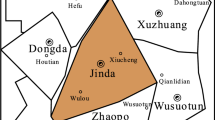Summary
A two dimensional finite element procedure is applied to simulate a coal mining excavation sequence. A procedure with linear solution steps is developed and applied to an idealized mountain cross-section with exceptionally thick coal seams and large dip angle. The results provide information on pillar pressure, floor and roof stability, displacement characteristics and surface subsidence.
Similar content being viewed by others
References
Desai, S.C. (1972) Theory and applications of the finite element method in geotechnical engineering, State of the Art, Overview, Trends and Projections, inApplication of the Finite Element Method in Geotechnical Engineering, Proceedings of the Symposium, Vicksburg, Missouri, May.
Gill, D.E. (1971) Report on Subsidence Associated with the Mining of Bedded Deposits (Submitted to the Subsidence Sub-Committee of the Canadian Advisory Committee on Rock Mechanics, Montreal) February.
Hittinger, M. and Goodman, R.D. (1978) A computer program for stress analysis of two-dimensional discontinuous rock masses. Department of Civil Engineering, University of California, Berkeley, Report No. UCB/ct/78-04.
Kripakov, N.P. (1981) Finite element analysis of yield-pillar stability,Comp. Structure 13, 575–93.
Langland, R.T. (1976) Three-dimensional FE analysis of a room and pillar coal mine (a comparison with experiment).Numerical Methods in Geomechanics, Vol. 2, June, Virginia Polytechnic Institute and State University, Blacksburg, pp. 802–20.
National Coal Board (1975)Subsidence Engineers' Handbook (Revised), London.
Obert, L., Duvall, W.I. and Merrill, R.H. (1960) Design of Underground Openings in Competent Rock. US Bureau of Mines, Bull. No. 587.
Pariseau, W.G. (1971) Influence of topography on the pre-mining state of stress, inProceedings of the Seventh Canadian Rock Mechanics Symposium, March, pp. 191–200.
Raney, E.M., van Dillen, D.E., Chuang, K.P. and Balachandra, M.B. (1976) Three-dimensional finite element analysis of coal mine crosscut and entry intersection, inProceedings of the Seventeenth Symposium on Rock Mechanics, Snowbird, Utah, August.
Zienkiewicz, O.C., Valiapan, S. and King, I.P. (1968) Stress analysis of rock as a ‘No tension’ material.Geotechnique 18, 56–66.
Author information
Authors and Affiliations
Additional information
The results presented here were obtained in the course of research sponsored by the Department of Energy, Mines and Resources, Grant No. 69-2570.
Rights and permissions
About this article
Cite this article
Huttelmaier, H.P., Glockner, P.G. Stresses and displacements due to underground mining using a finite element procedure. International Journal of Mining Engineering 3, 49–63 (1985). https://doi.org/10.1007/BF00881341
Received:
Issue Date:
DOI: https://doi.org/10.1007/BF00881341




